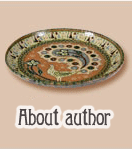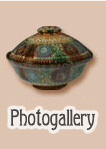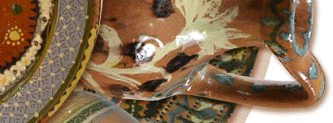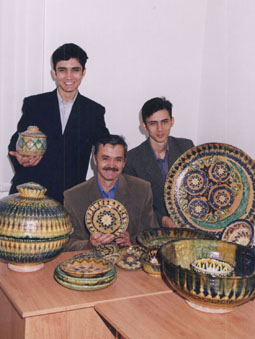










Dynasty of masters-keramists of
Narzullaevs from Gizhduvan
(From a two hundred year's history).
The XVIII-th century beginning there has come strong revival in a life of handicraftsmen both the Bukhara, and Gizhduvana located near to it. Since then popularity of gijduvan potters though in a city there were many good masters both on metal, and on a tree, and weavers, and naboechniks also has gone. In Gizhduvane there lived tens of ceramists, is masterful producing and painting ware. And, here there were the masters, which formed and painted ware, and were also such which only painted. The last were called «nakkosh» - the draughtsman. In Gizhduvane many visitors ceramists from Karshi, as Shahrisabz, Samarkand, from Khiva and Urgench worked. Here young potters were flown down to study or improve the skill on all nearby district, first of all in the Bukhara, in Vabkente, then in a Katta-barrow, Nurate, Karshi.
One of founders of potter's manufacture and dynasty of kulols of Narzullaevs, the continuer of gijduvan tradition Sharofiddin Gizhduvony (Sharofiddin-chinnipaz) is considered schools of potters.
Sharofiddin Gizhduvony was born in 1790 in Gizhduvan and has become famous as the master - chinnipaz. Till last days of a life, - 1885 it has worked with the son - Usto Ergash-kulolom. In ceramics of Sharofiddina Gizhduvony and Usto Ergash of the Dome, it was natural much in common. They often used the same ornamental motives though Usto Ergash kulol was more well-known as master kosagar. Unfortunately, products of potter's craft of that period have badly remained. Only not numerous samples of their works are stored in museums, or fixed in photos in albums. It is necessary to notice that attentively considering even those the a bit numerical remained samples of ceramics it is possible to assert that products created by the father and the son, the teacher and the pupil, are original:
In them the fantastic riches and brightness of the flower patterns, the sated colour of lists of dishes, their decorative effect, despite a low technological level and is primitive-handicraft character of manufacture is underlined. Traditions of a dynasty of Narzullaevs were continued by two sons Usto Ergash-kulola - Usto Narzullo (in historical sources it is called as Narzi) Ergashev and Usto Tosh Ergashev. Both brothers have become famous as skilled masters-kosagars. Samples of their works are stored in many republican and foreign museums.
In works of brothers of Ergashevs certain law is traced - to inform art expressiveness to subjects of practical application, in particular ware. And, features of drawing of a ceramic decor were caused by its appointment and problems of a harmonious combination to the form. These both other specific principles and subtleties of skill and the creative approach to results of work always were consistently and precisely observed by brothers of Ergashevymi. It is necessary to notice that Ergashev Narzullo has died in 1932, and Ergashev Tosh has been subjected to repression in 1937. It was taken away at night by workers of People's Commissariat of Internal Affairs and more it nobody saw. So, have extrajudicially finished with well-known ceramists, whose works and now are very highly appreciated by experts. What, such danger to «Great Power» was represented in those days by the rural illiterate slogger who and talent worked wonders with the work, as well as ten thousand innocently subjected to repression of uzbek peoples, the mind boggles. Probably, someone was irritated with thought on that, as in the forgotten corners of the country, and at "other" people great people about whom experts of all world will start talking can be born. It was extremely destruction of national values.
Traditions of a dynasty of Narzullaevs Usto Ibodullo Narzullaev - one of the brightest representatives of potter's art of Uzbekistan, the son well-known usto has continued Narzullo Ergasheva. Ibodullo Narzullaev, - a member of the Union of Artists of the USSR, a member republican union "Usto" the winner of numerous competitions, the gentleman of an award «Mehnat Shuhrati» was born in 1927. He in literal sense has grown in a workshop of the father and the uncle. After tragical events of 1937, it has adopted known kulol Usto Usmon Umarov, having married mother Ibodullo. Usto Usmon Umarov is considered the pupil of the uncle, - Usto Muhammadzhona Chuloka and his father - Usto Muhammad Sadykov (1850-1920). Usto Usmon Umarov was coeval Tosh Ergasheva, often happened in their workshop, consulted and took lessons from Usto Narzullo Ergasheva. After adoption of Ibodullo actually two kulol dynasties have united also their continuer there was Ibodullo Narzullaev. I.Narzullaev became a new prototype of the national master-keramista, among born on uzbek earth. It was not simply presented person who has adopted traditions of ancestors, adhering which developed them. He meaningly put before himself new problems and aspired in process of forces and possibilities them to carry out, moving ahead on a formidable, thorny creative way the road. It is curious that Usto Usmon Umarov opposed engravings of patterns on painted vessels, and I.Narzullaev often followed this original manner. Ibodullo Narzullaev the first has revived and has entered into ceramic manufacture the basma technics. He also successfully used technics graphic - hona-is good. I.Narzullaev worked more often on white angoby , covering dishes and thickets of salad tone, paternal they as a whole possessed light, greenish colour. Colour of the best works of Usto Ibodullo Narzullaevl colourful riches to the uniform tone decoratively painting rhythmic game colourful drawings, merging with each other and contrasting among themselves. I.Narzullaev - this talented, searching, formed master has been keen on searches of new patterns. In its decor meet not only motives of a clap, it posesses also a known dish with entered facade of the mausoleum of Samanids. This decorative dish is sustained in traditional gijduvan to brown scale. I.Narzullaev - the master sharply feeling changes and appreciating history. It scooped themes from the diversified sources. In 1956 he has painted a dish, having decorated it in the centre with Picasso's flying pigeon. This contact of Bukhara national ceramics and the French art, contact of a theme of a fight for peace, is remarkable in itself. I.Narzullaev was the fine draughtsman. It transferred the ceramic patterns on a paper in a pencil and paints. Later it worked over ceramics manufacturing techniques much.
Products of Usto Ibodullo Narzullaev were shown in Alma-Ata (nowadays Almaty)/Kazahstan/and Tbilisi/georgiya/, Leningrad (nowadays St.-Petersburg) and Moscow/russia/, Dresden/germany/, Bruxelles/, Washington and New York/ Usa/, Rome (Italy), Tokyo/Japan/, Warsaw/Poland/, Ulan Bator/mongolia/, Delhi/india/, Shanghai and Beijing/China/, Ostende, Geneva, Minsk, Belgrad, Montreal, in other cities and the countries. And in their Uzbekistan there was in general an infinite quantity.
Works of Usto Ibodullo Narzullaev are bought by the Dushanbinsky museum of the fine arts, the Moscow museum of the people of the East, a museum of the Geneve international Academy of ceramics, a museum of the Moscow higher is art-industrial school, the State historical museum of the USSR, the Museum of world ceramics in Faience, Fund of Academy of arts of Georgia, museums of Japan, France, Belgium, Poland, the USA and other countries. Set of its works are at private collectors.
Among them: German artist Timman, K.M.Simonov, V.B.Elkonin. Professor S.A.Mits, scientist-archeologist S.N.Jurenev and others.
Usto Ibodullo Narzullaev often repeated: «We a family of kulols. But we should know that is very much both very skilful and skilful masters at whom we should study. Among them - Rahimberdi-ota Machchanov, Ibrohim-ota Komilov, Ahad-ota Muzaffarov, Abdurajim-ota Muhtorov, Usto Umar Zhurakulov, Fatullo-ota Sadullaev, Hamrobibi Rakhimov and many other things. In a family of Narzullaevyh recollect words of the father about Azim Kulole (Azim of"Shajton") / has died in 1945 from Gizhduvana:« He created a miracle from clay ». I.Narzullaev has left an unforgettable trace in the history of ceramic art. At it was eleven children. It is necessary to notice that almost all children well own receptions of ceramic craft, and one not only has gone in the footsteps of the father, but it is considered the big, world-wide recognised master of potter's art is Alisher.



Dynasty of masters-keramists of
Narzullaevs from Gizhduvan
(From a two hundred year's history).





